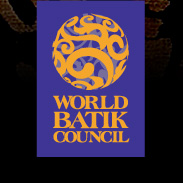
|

The origin of batik is shrouded in mystery because fabric disintegrates, making it impossible for historians to pinpoint when the technique was first discovered.
The earliest evidence can be traced back to China and India, from which it travelled to the rest of the world.
China
The Miao tribe of China developed batik as a folk art that can be traced back 2,000 years. Batik is still produced by the Miao tribe today.India
India is believed by some scholars to have pioneered batik sometime in the first century. They called it "kalamkari".India was active in the export of batik and the merchandise can be traced to ancient Egypt, Southeast Asia and Europe.
Java
But it was the Javanese who embraced batik and made it their own. Javanese batik began in the ancient city of Cirebon in 1378. Only members of the nobility were allowed to wear certain patterns.Cirebon grew to become a meeting place for traders travelling the South China Sea and the Indian Ocean. The influence of Islam changed Cirebon batik from animal motifs to abstract geometric designs.
Pekalongan later emerged as a flourishing centre for the batik business. Here the Indische people, who were Europeans or European-Asian mix, became the most influential designers.
By the mid 19 th century, a strong Chinese middle class influenced the batik business in Java, producing very fine work.
Tuban, once a glorious kingdom, has it own unique history in batik. Tuban grew its own cotton which was spun and woven into cloth that was used to produce batik.
Europe
The East India Company, encompassing the Dutch, British and French components, in its extensive trade with India brought superior quality dyed Indian textiles into Europe.Indian batik, known in Europe as Chintz, became very popular and in fact greatly influenced the development of English and French textiles.
The Industrial Revolution made it possible for the Europeans to mass-produce batik of fine quality and batik became very fashionable in Europe.
Javanese craftsmen were brought to teach the batik technique. Flowers were the main motif throughout the 19th century. The use of bright colours suggested higher social status.
Malaysia
The origins of batik in Malaysia are obscure. However, the states of Kelantan and Terengganu are recognised as the cradle where batik grew in Malaysia.Although evidence of batik activity can only be traced to the 18th century, it is believed that batik goes back to an earlier period owing to the influence by China, India, and Java.
The Sultans were mainly responsible for the growth of batik in these two states. They encouraged experimentation of techniques in mass production and helped to expand the industry.
Several techniques were developed to improve the quality of batik produced in these states. Malaysian batik was in demand in Burma, Sarawak and Brunei where it was exported.
The industry suffered a big blow with the Japanese occupation of 1942-1945 when many factories were closed down.
However, the Japanese influence can be seen in the emergence of batik called Hokokai that had strong Japanese motifs and bright colours.
Upon achieving independence in 1957, Malaysia looked to batik to create a national identity. It became the official national attire for formal occasions.
By the 1990s batik had lost its magic. It was only in 2003 when it began to bounce back with renewed vitality.
The untiring efforts of Datin Paduka Seri Endon Mahmood, wife of the Prime Minister, Dato' Seri Abdullah Ahmad Badawi, gave batik back its dignity and its national status. She championed the craft by encouraging young designers to use their creativity to explore new ways of using batik.
The Piala Seri Endon is now a coveted trophy for designers to showcase their ability to take batik to new heights of excellence.
Batik today
Batik has evolved into a unique art form that has inspired people all over the world.Batik is a versatile art form that lends itself to any kind of creative expression. Today, you can see batik as paintings or used on lampshades, footwear, picture frames, bed-sheets and other items of lifestyle design.
